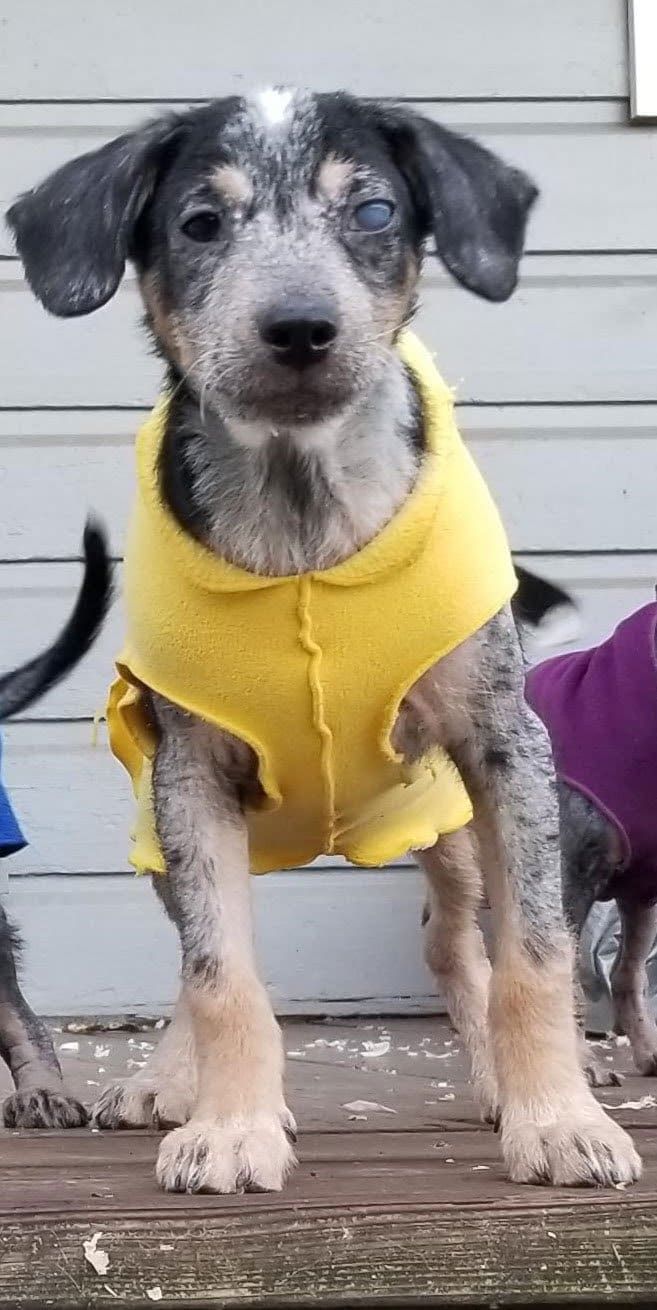If there is one thing that all of us who are in and around these buildings have in common, it’s that our animal companions are critically important to us, whether they are huge (like the Great Dane puppy I saw in the main receiving area five hours ago) or tiny (like the ancient, doddering Pomeranian wearing a cone who just hobbled out of another exam room in the ophthalmology department).
However, your purebred Springer Spaniel with the gleaming, show-worthy coat and condition is no more important than my scruffy, mange-recovering, mixed-breed shelter puppy. Thank goodness, we are all equals in the eyes of the dedicated vets, vet techs, vet students, and even the support staff at the front counter and answering the phones. These people exude compassion for every human and every non-human animal equally.
When you see a person carrying a dog bed wrapped in a blanket with just a dog’s nose sticking out, and the person has obviously been crying, don’t even think about asking a question or even saying anything in a consoling tone. Just smile and look away. No one wants to be observed or explain anything at a time like this.
No one who works in or visits this sector of the campus will walk past an animal without a smile, from the custodians to the vets to other pet owners.
There is no one kinder than a veterinary student. Period. They are equally interested, friendly, appreciative of the pets in their care, polite and sweet to owners, patient when taking even very long-winded histories, and earnest. They have thanked ME for caring about the shelter pups I’ve brought here. I’m old enough to be their mother, but every single one that I’ve cried in front of in the past week – and I think we are up to at least three or four, at this point – has been so compassionate and kind that it makes me cry again, just thinking about that.

It isn’t just well-heeled people visiting the veterinary oncology, ophthalmology, and other specialty departments that are in this building. I mean, it’s impossible to know for sure, but judging from the cars in the packed parking lot and the people I see waiting in the waiting rooms with me, we are from every socio-economic strata and racial background. If our pets need a specialist, they need a specialist. And so we are here, taking what inspiration we can from the posters about various veterinary success stories that line the walls and halls.
There is nothing so gloriously thrilling as an obviously healthy, thriving dog dancing out of a facility like this. Perhaps he was here only for a checkup, or maybe his treatments healed him. Either way, it makes all of our hearts glad to see him.

*I am back at the Veterinary Medical Teaching Hospital [VMTH] at UC Davis, just a week after my last visit. Last week, I was here with a dying puppy. This week, I’m here for an emergency ophthalmology consult for another puppy from the same foster litter.
Not quite three weeks ago, the biggest, strongest pup in the litter suddenly developed a big swollen eye. My local veterinarian prescribed one course of treatment, and a week later, another, but the eye hasn’t responded. Since the origin of the problem is still a bit of a mystery (a scratch was suspected, but no actual injury to the surface of the eye was observed), he has started to suspect that the cause is not an injury but some other disorder. Hence, a higher-tech consultation.
The pup has been prescribed a whole new course of oral and topical medicines: gabapentin for pain, doxycycline in case it has been caused by a tick-borne disease or even leptospirosis, and, to reduce the dangerous fluid accumulation in the eye, a low-dose oral steroid, a saline ointment (to be applied six times a day) and an NSAID eye drop (to be applied four times a day). And we will recheck in a week.
You guys, this puppy is a champ. He’s so well behaved that people keep mistaking him for being very ill; after a few minutes of sniffing around and me rewarding him with little treats for staying on the little blanket I brought for him, he curls up in a ball and resigns himself to a few more boring hours. What amazing self-control for such a little guy!
However, given the practically hourly regimen of eye medications we’ve been dealing with in the past two weeks, he’s bonded to me very strongly. The ophthalmology intern took him into the back for about an hour, and I took the opportunity to go in search of a snack vending machine and a restroom. When I got back, I heard the puppy’s loud complaints (he is a howler) from a cage in a room a few doors away from the waiting room. As soon as the doctors were done with him and the intern saw that I was back, he was brought back to me and he settled back on his little blanket without any further fuss. He’s such a good boy!

Also, folks, he needs a name. I usually assign my foster pups a different colored collar for the few weeks they will be with me, and refer to them by the color of that collar. But this bunch has needed so much help, and since we want to make sure that the health conditions they are fighting as a result of their early abandonment and subsequent malnutrition (demodectic mange, wonky legs, and now this vexing eye issue) are completely resolved before we even try to find them forever homes, they are going to be with me for a good bit longer than usual. It’s well past time for a real name, even if it gets changed when he finally finds a home.
My friends keep calling this puppy Blue, both for his blue merle color and now, sadly, for his compromised eye, but that’s confusing, because he’s the puppy who has been wearing the yellow collar and coat. When the ophthalmologist asked about his name, I told her that he’s the yellow collar puppy, but my friends keep calling him Blue, and that I didn’t want to name him for a condition we were hoping to resolve. She laughed and said, “All my pets are named after the conditions that brought them to me!” When I, also laughing, asked her for an example, she said, “Well, for starters, my cat Ringo came to me with ringworm…”
Anyway, suggestions for a name would be gladly accepted.
As would donations for the medical bills that he and the other puppies have incurred. The donations that the shelter has received are what’s making all this medical care possible; we have done much more for these puppies than this open-admission shelter or I are usually able to do. And for that, I am so grateful. This is an extremely worthy bunch of pups, and I’m so glad that they are going to get a real chance in life, instead of being euthanized for severe but highly treatable conditions.
If you are so moved to make a year-end, tax-deductible gift, please go to northwestspca.org and click on “Donate.” You can specify that your donation be used for the medical care of the mange puppies. If there is any money left over by the time these guys are out the door, healthy, neutered, and microchipped, the money will go into the shelter’s medical fund to be used to help other special cases. And thank you from the bottom of my heart.






